After its union with England in 1707, Scotland retained its own legal, education and church systems. It was integrated into the United Kingdom political structure, represented in 1915 by 72 members of parliament (MPs) in Westminster, London, out of a total of 670 including all of Ireland. The Secretary for Scotland was Thomas McKinnon Wood (Liberal), MP for Glasgow St Rollox, born in London to Scottish parents.
Scotland was a Liberal Party stronghold, with the Conservatives in distant second place. Dundee had one of the first Labour MPs in Scotland (Alexander Wilkie) and was unusual in that it had two MPs; the other was Winston Churchill, Liberal.

The Scottish economy was based primarily on shipbuilding, iron and steel production, coal mining, textile manufacturing, farming and fishing. The Clyde valley in the Glasgow area was an industrial powerhouse and was a vital source of ships and munitions.

Although the overall population of Scotland grew from 1.8 million to 4.8 million in the hundred years to 1911, it declined in northern Scotland due to the latter stages of the Highland ‘clearances’ (tenant evictions) and people looking for opportunities elsewhere in the UK and overseas. There was also significant population movement out of southern Scotland, although with less coercion.

See also